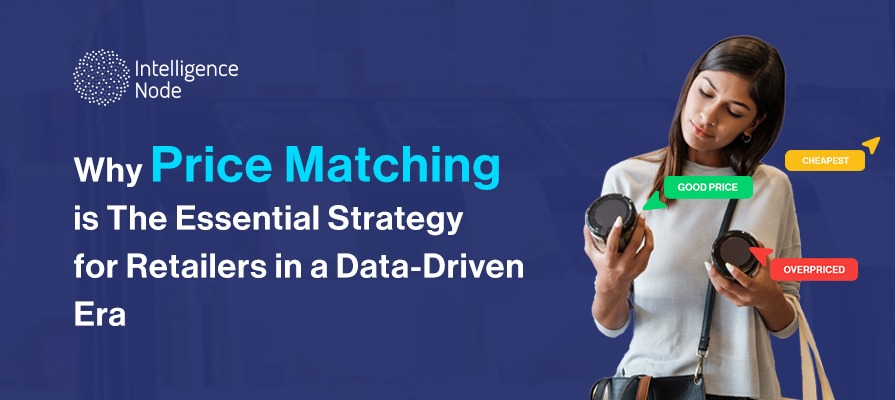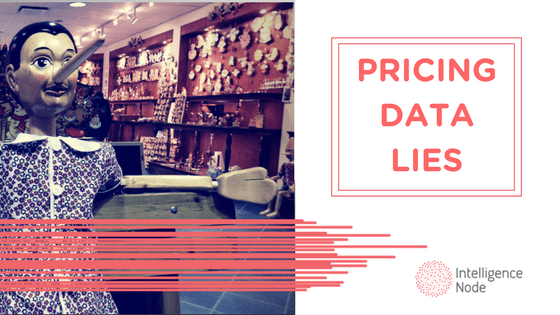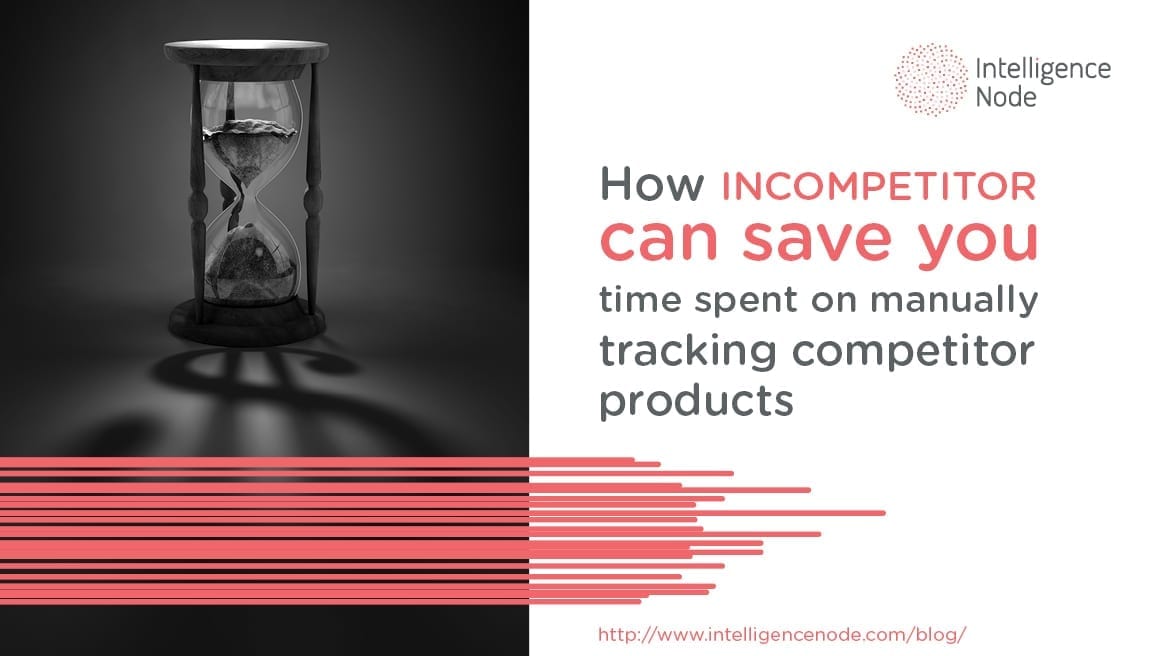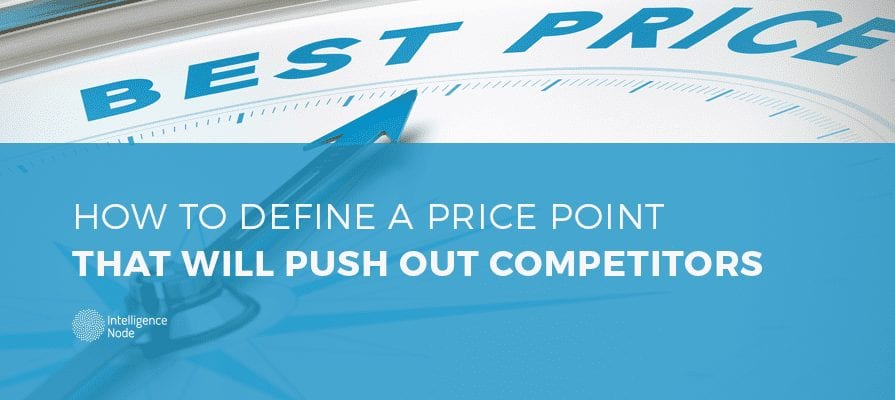The 2024 economic climate has heightened shopper price sensitivity. This shift has sparked a retail revolution with dynamic, data-informed pricing strategies and cutting-edge technology. This surge in price consciousness among consumers has compelled retailers to refine their pricing tactics, moving beyond traditional competition or luxury positioning to more nuanced, data-driven models. In this context, both eCommerce and brick-and-mortar stores are embracing sophisticated technologies to cater to a broad spectrum of consumer expectations, ensuring prices accurately reflect market dynamics and consumer preferences. Within this transformed landscape, “price matching” stands out as a key strategy for retailers determined to demonstrate their commitment to value and to stay competitive against local retailers and competing brands.
What is Price Matching & How Does it Work?
Price matching is a competitive strategy employed by retailers to assure price-sensitive customers they are getting the best deal available on the market. This policy allows a customer to receive a product for the same price offered by a competitor. It ensures the customer doesn’t need to shop elsewhere to benefit from lower prices. Here’s how it typically works: A customer finds a lower price for an identical item at another retailer and presents this evidence to the original retailer. This can be in the form of a flyer, a website listing, or a formal quotation. Upon verification of the competitor’s price, the original retailer adjusts the price of their product to match the competitor’s. This includes ensuring that the item is identical in brand, model, and currently in stock.
This practice is beneficial for both consumers and retailers. Consumers gain the advantage of spending less time and effort searching for the best price. Shoppers are confident in the knowledge that they can rely on price-matching policies. For retailers, it fosters customer loyalty and prevents loss of sales to competitors. This helps keep retailers competitive in a market where price is a significant factor in purchasing decisions. While the strategy can vary significantly between companies in terms of eligibility, time frame for price match requests, and the types of proof accepted, they share the common goal of offering customers the best value for their money.
Top Retailers Leveraging Price Matching
Walmart has integrated its price match policy as a key element of its price management strategy. Referred to as ‘Everyday Low Prices’, this includes focusing mainly on matching prices from its own websites. This approach has enhanced business operations and profitability while ensuring customers receive competitive prices, maintaining customer loyalty.
Target offers a generous price match policy, matching in-store prices with over twenty-five competitors, including Amazon. It also allows price adjustments on purchases within the past fourteen days. This means providing refunds for price differences, thereby enhancing customer satisfaction.
Home Depot promises to match lower prices found on its own or competitors’ websites. This deal includes shipping costs, with certain exclusions like open-box or reconditioned products. This policy is part of Home Depot’s strategy to offer the best prices while setting limits to maintain profitability.
Staples not only matches but beats competitor prices by offering a 110% price match guarantee. This entails a 10% discount above the price match guarantee. This policy applies to both retail and online prices, including those on Amazon. The offer demonstrates Staples’ commitment to providing superior value and savings to its customers.
Optimizing Price Matching Strategies for eCommerce
Technology, especially advancements in AI and retail analytics, is fundamental in facilitating and optimizing price matching strategies, ensuring they are both efficient and effective. Intuitive, next-gen retail technology allows for real-time monitoring and adjustment of prices across a wide spectrum of products and retailers, guaranteeing that data is consistently up-to-date. Such capabilities are crucial for retailers aiming to respond swiftly to market changes, enabling them to adjust their prices in real-time to stay competitive.
Automating Price Matching With Analytics
Primarily, retail technology streamlines the price matching process through automation. Retailers can establish predefined rules for automatic price adjustments, minimizing manual efforts and ensuring quick adaptation to market dynamics. This not only maintains competitiveness but also enhances operational efficiency. Moreover, these technological solutions enhance the customer shopping experience. Price matching guarantees can be integrated directly into the shopping platform, providing customers with instant notifications if a product is available cheaper on a particular seller’s platform (for marketplaces) or to provide notifications for key items at their lowest price, and offering immediate price matches. This level of service fosters trust and loyalty, significantly impacting a retailer’s market presence.
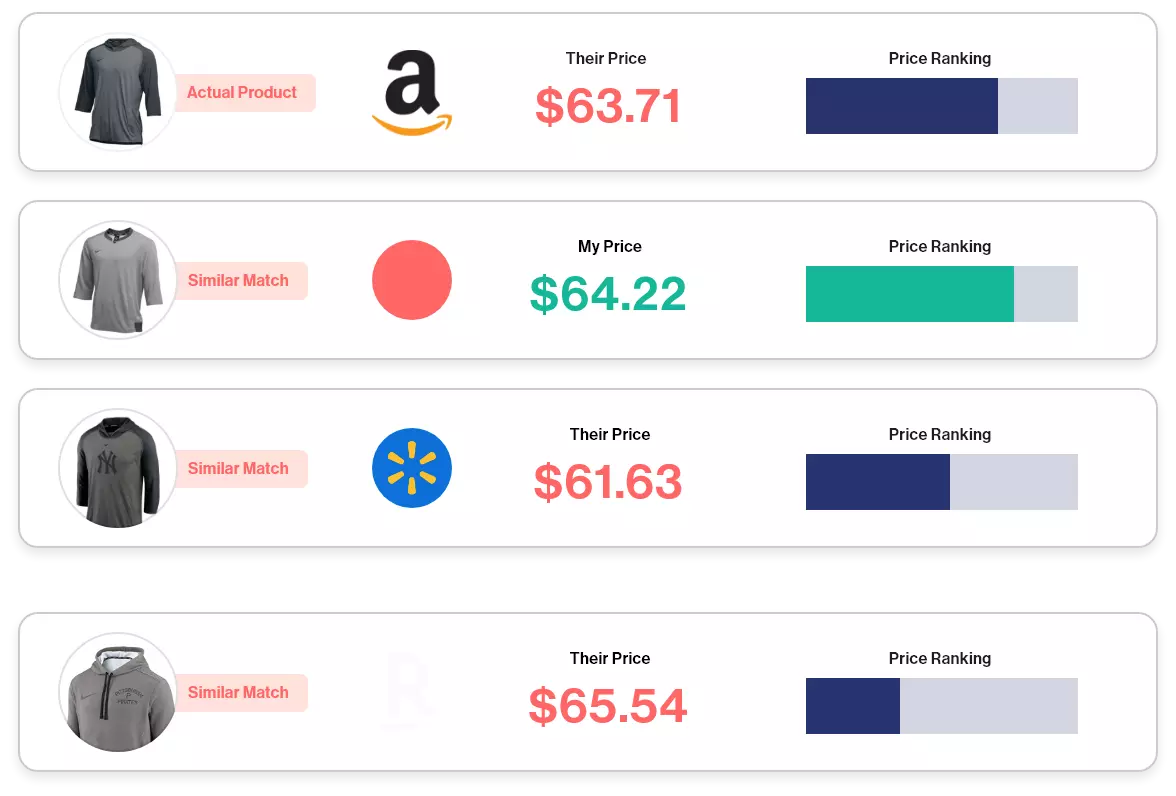
Incorporating such advanced technology in pricing strategies allows retailers to not just react to the market, but proactively manage their pricing in a way that promotes customer loyalty, maintains competitiveness, and ensures profitability.
Tips for a Successful Price Matching Strategy
- Leverage AI for Real-Time Price Monitoring: Utilize artificial intelligence tools to continuously monitor competitor prices across multiple platforms in real-time. This enables quick adjustments to your pricing strategy, ensuring competitiveness without constant manual oversight.
- Products Must Be an Exact Match: Ensure that the items are perfectly matched, down to the bar code, to confirm that both products are identical in terms of variants, size, and other specifications before implementing the price match policy. This ensures a fair and accurate price comparison.
- Ensure Local Availability: For a price match, the competitor’s lower-priced item should be available within the same geographic region. Utilize zip-code price monitoring technology to verify local availability and ensure market relevance and competitive fairness.
- Specify Accepted Proof Types: Clearly outline the types of acceptable proof for the competitor’s lower price, such as a physical flyer or a digital record (website price, online flyer). Establish and communicate the parameters for their validity within the terms of the price match policy, enhancing transparency and customer trust.
- Use Mobile Verification Apps: On digital shopping platforms, encourage customers to use a mobile app for price matching requests, where they can easily upload proof of a competitor’s lower price. This streamlines the validation process and enhances the customer experience by reducing wait times and manual checks.
- Define Sales Exclusion Policies: Consider excluding certain sales from the price match guarantee, like holiday sales. Items on clearance, promotional freebies (e.g., buy-one-get-one offers), as-is or demo models, and other special promotions typically do not qualify for price matching. This distinction helps maintain the integrity of sales strategies while ensuring the price match policy is sustainable.
- Confirm Competitor Stock Status: Ensure the competitor’s lower-priced item is available in stock, preferably within the local area, to qualify for price matching. This criterion prevents the price match policy from being exploited through comparisons with out-of-stock or unavailable items, ensuring the policy is both fair and practical.
- Integrate CRM for Personalized Offers: Combine your Customer Relationship Management (CRM) system with price matching policies to offer personalized price matches based on customer loyalty and history. This can help retain valuable customers and personalize their shopping experience.
Pros & Cons of Price Matching
Implementing a price matching strategy can be a double-edged sword for retailers. While it can be an effective tool to attract customers, it requires careful consideration and strategic implementation. Adopting the right technology solutions is crucial for retailers implementing this strategy, as it directly impacts profitability and competitive edge. Advanced retail analytics powered by intuitive AI enables real-time competitor price monitoring, dynamic pricing, and personalized customer experiences. These tools help maintain profit margins while ensuring competitiveness, streamlining the price matching process, and enhancing customer loyalty. Proper technological support ensures the strategy’s success, balancing customer attraction with financial sustainability.
Pros
- Immediate Competitive Advantage: By offering to match the prices of competitors, retailers can instantly make their offerings more attractive to price-sensitive customers thereby preventing them from shopping elsewhere. This direct response to competitive pricing helps maintain market share.
- Enhanced Customer Trust and Loyalty: Customers perceive price matching as a retailer putting their interests first, leading to increased trust. This goodwill can translate into higher customer retention rates, as shoppers feel more confident they’re receiving the best deals available.
- Increased Sales and Market Presence: Adopting a price match policy can lead to an uptick in sales volumes. Customers inclined to comparison will favor retailers who offer price matching. Such offers guarantee they won’t need to go elsewhere for the best price. This strategy not only boosts sales but also enhances the retailer’s reputation as a customer-centric store.
Cons
- Margin Compression: To match a competitor’s lower price, retailers often have to sacrifice their margins. This can be particularly challenging for businesses with higher operating costs, leading to financial instability if not managed carefully.
- Risk of Price Wars: Price matching can inadvertently lead to a cyclical lowering of prices between competitors. This is known as a price war. Such scenarios can, over time, quickly erode profitability for all involved. It can also destabilize the market, often to the detriment of product and service quality.
- Encourages Competitor Comparison: While intended to retain customers, price matching policies may encourage shoppers to constantly check competitors’ prices. This may even increase the risk of losing shoppers, especially for smaller retailers. This can result in a net loss of business if they are unable to sustain continuous price reductions or lack the broader appeal of larger competitors’ product assortments and loyalty programs.
CONCLUSION
Advanced retail technology stands at the forefront of enabling retailers to navigate the complexities of matching with precision and efficiency. These technologies not only streamline the implementation process but also enhance the effectiveness of the strategy, thereby helping retailers achieve a delicate balance between attracting customers and maintaining profitability. Intelligence Node is a market leader in offering advanced, real-time price matching analytics using proprietary AI. To learn how your business can adopt and integrate Intelligence Node’s next-gen tech to enhance your pricing strategy,, book a demo today!
